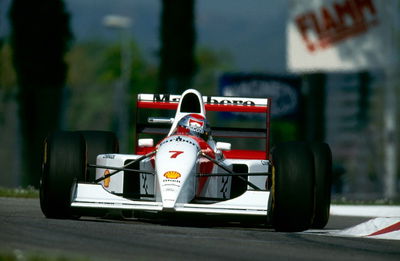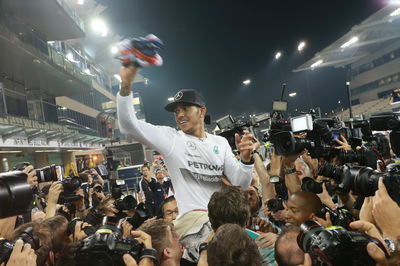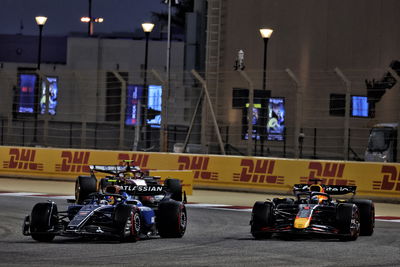Six of the Best: Second generation strugglers

Max Verstappen's run-out in Friday practice at the Japanese Grand Prix placed him in a very select group of second generation drivers who have taken part in a Formula One race weekend - an assembly he'll properly join from the start of the 2015 season and his full debut with Toro Rosso.
Genetic disposition is no cast-iron augury of success though, and the fortunes of F1 racing's sons have fluctuated wildly. For every Hill, Villeneuve or Rosberg, there are a legion of second-generation F1 racers who, due to a variety of circumstances, never made the grade.
Time will tell which side of the divide Verstappen will ultimately fall on, but now seems a good time for a cautionary remembrance of six racers for whom a famous name was about the sum total of their F1 achievements.
MICHAEL ANDRETTI
Perhaps the most infamously disappointing familial second coming was that of Michael Andretti, son of 1978 F1 World Champion and motorsport legend Mario Andretti, whose Grand Prix career lasted just 13 desperate races for McLaren in 1993.
The 1991 CART champion, Andretti had certainly demonstrated pedigree in American open-seater racing, although his appointment to race alongside Ayrton Senna for a declining McLaren was as much due to his ability as by Bernie Ecclestone's desire to see a leading American name on the grid.
With great names come great expectations, although they were unfortunately swiftly revised in Andretti's case. Andretti's penchant for early collisions, including a terrifying airborne accident at the start of the Brazilian Grand Prix, meant that he only completed three laps across his first three races. This dismal first impression was consolidated by the seemingly arrogant fact that Andretti refused to relocate to Europe, preferring to commute to test sessions and races from the USA.
Compounding the misery was a pure lack of performance, especially when compared to his triple-World Champion team-mate. Andretti struggled with the technical complexities of active suspension and traction control-loaded Formula One Cars, and had the misfortune of racing alongside an inspired Senna - who would somehow haul the McLaren-Ford MP4-8 to five victories throughout the season.
Andretti would manage three points-scoring finishes, but there was little discernible sign of improvement throughout the campaign - with poor reliability and an enduringly expensive habit of accidents, not to mention the fact that McLaren had a quick and race-proven test driver in Mika Hakkinen waiting in the wings, contributing to an ever more tense relationship.
The end was swift, with Andretti and McLaren agreeing to part ways after the 1993 Italian Grand Prix. A farewell podium finish at Monza was an unexpectedly strong sign-off, but it was too little too late. Further success Stateside proved Andretti's calibre, but his time in Formula One was nothing short of an embarrassing disaster for all concerned.
DAVID and GARY BRABHAM
Following in the footsteps of your father in any circumstance is difficult, but when the father in question is a three-time World Champion who managed the unique feat of winning the title in a car bearing his name, winning 14 Grands Prix across a 16-year career in the process, then those footsteps require rather large shoes to fill. Enter David and Gary Brabham, sons of Sir Jack Brabham, and unwitting members of the 'toughest act to follow' hall of fame.
David, Sir Jack's youngest son, has forged a highly successful career as one of the world's premier sportscar specialists, but his time in Formula One was certainly less auspicious. Taking familial inspiration to a highly literal idolatry, David made his debut for the Brabham team in 1990.
Although David had to raise considerable sponsorship to even earn a drive with the team, it was a neat quirk of circumstance to once again see a Brabham at the wheel of a Brabham. That would be about the sum of the season's positivity though, with David only qualifying the hopelessly uncompetitive Brabham-Judd BT58 six times in the fourteen races he entered. Unable to raise the required $3m to keep his seat for 1991, David left the team at the end of the season.
The younger Brabham would endure a second stint as a rolling roadblock in 1994 as lead driver for the under-funded Simtek operation, although David would earn considerable praise during the season for his determined leadership after the tragic death of team-mate Roland Ratzenberger at Imola.
Elder brother Gary fared even less fortunately during an even briefer dalliance with F1, entering two races for the hapless Life team at the start of the 1990 season. Life was probably the worst entry in the history of the sport, operating a single car with one overly heavy chassis, one horribly underpowered engine, and running at approximately Formula 3 pace throughout each of the team's doomed efforts to pre-qualify across the season.
Gary lasted only two races (in which he failed to get within 30 seconds of the lap time of the next slowest runner - and was almost a minute down on the pace of the leading cars) before walking away, never to return to F1.
Both brothers subsequently found their feet, David as a sportscar racer and subsequent Le Mans winner and Gary racing in CART before becoming an advanced driver training coach, but the legacy of the Brabham name in Formula One remains the sole preserve of Sir Jack.
NELSON PIQUET, JR.
If talent isn't necessarily hereditary, then neither is character. Nelson Piquet Jr. fortunately failed to inherit his father's brash abrasiveness, but also missed out on the family's championship pedigree genes - leading to an F1 career that would have been almost completely forgettable were it not for his infamous role at the heart of the 'Crashgate' scandal.
Nelson Jr. had ascended to F1 on a gilded glide up the junior racing ladder, his family's wealth allowing him to race for his own team in every Formula up to GP2. Promoted to the Renault F1 team alongside Fernando Alonso for 2008, Piquet Jr. endured a stuttering start, scoring only two points in the first half of the season and being publicly barracked by Team Principal Flavio Briatore due to his poor performances.
Piquet Jr.'s prospects improved with a fortunate second place after (ironically enough) the timely intervention of the safety car in Germany, but it was his accident at the inaugural Singapore Grand Prix that would come to define Piquet Jr.'s career.
His crash on lap 14 in Singapore looked like nothing more than a characteristic error, and the conveniently timed safety car period that allowed team-mate Alonso to jump up the pack and ultimately take victory was initially dismissed as coincidence. Piquet Jr. raced on through the end of the season and into 2009, but ever-diminishing returns saw him dismissed by Briatore 10 races into the season.
Sensationally, a vengeful Piquet Jr. blew the whistle on the 'Crashgate' plot, making statements to the FIA accusing Briatore and Pat Symonds of ordering him to crash in Singapore to help Alonso win the race. Briatore and Symonds were summarily dismissed and banned from F1, and substantial damages were awarded to Piquet after libelous allegations made against him during the FIA hearings.
However, Piquet Jr. would never race again in F1, despite the efforts of Bernie Ecclestone to manouevre him into a race seat for 2010. Mixed results in various series post-F1 have further reduced Piquet Jr.'s stock, and Nelsinho can now be found heading up the China Racing effort in Formula E. Irrespective of circumstance or misfortune, clearly the racing genius that propelled Nelson Piquet Sr. to three world titles was sadly entirely absent from his son's brief career at the top table.
CHRISTIAN FITTIPALDI
Brazil' first family of motorsport have produced three Fomula One drivers and a well-established Grand Prix team, but pretty much all of the Fittipaldi clan's achievements in F1 can be attributed to one man: double World Champion Emerson Fittipaldi.
Emerson's elder brother, Wilson Fittipaldi, competed alongside him in 38 Grands Prix in the 1970s, scoring three points and is best remembered for convincing Emerson, at the height of his success, to leave McLaren for the ultimately doomed Copersucar-backed Fittipaldi Automotive effort.
Although the Fittipaldi team folded at the end of the 1982 campaign, a decade later the Fittipaldi name would return to the grid in the form of Wilson's son, Christian. A highly rated junior driver, Christian was catapulted into Formula One, aged just 21, with Minardi in 1992.
Despite mild success and a few points-scoring finishes, the younger Fitipaldi's form was more reminiscent of his father than his uncle, and his career is best remembered for a crash that has become a staple of 'what happened next?' quizzes - a spectacular 360? flip down the start-finish straight after colliding with team-mate Pierluigi Martini at the 1993 Italian GP.
Dropped by Minardi at the end of 1993, Fittipaldi resurfaced at Footwork ahead of the 1994 campaign. Fourth place finishes at the Pacific and German GPs represented Fittipaldi's highpoint, but the Brazilian wasn't retained for 1995, and left F1 for good at the end of the season.
A second place in the 1995 Indianapolis 500 and subsequent race wins in CART and sports prototypes proved Fittipaldi's calibre, but, like his contemporary Michael Andretti, Christian Fittipaldi's F1 legacy amounted to little more than a footnote in his family's storied history in the sport.
MARKUS WINKELHOCK
From racing dynasties to more humble family fortunes, Manfred and Markus Winkelhock are perhaps the least conspicuous father/son duo in F1 history. In this case though, while both generations found themselves cast as backmarkers, it was son Markus who would leave the most indelible impression on Formula One.
Manfred's F1 career amounted to four seasons of mostly struggle with Arrows, ATS and RAM in the early 80s, before he was tragically killed during a sportscar race in Canada midway through the 1985 season.
Markus was only five when his father died but pursued a racing career nevertheless, eventually graduating to Formula One for his one and only appearance at the N?rburging in 2007 - drafted into the flailing Spyker team in place of Christijan Albers for the European Grand Prix.
Qualifying last, 1.5 seconds down on teammate Adrian Sutil, Winkelhock's expectations were no mightier than an afternoon of trundling mobile chicanery. However, inspired opportunism by the Spyker team at the end of the formation lap saw them pit Winkelhock for wet tyres as rain began to fall ahead of the start.
In traditional Eiffel Mountain style, the spots of rain became a deluge, and Spyker's gamble turned into a masterstroke. Winkelhock quickly assumed the lead, passing the flailing leaders as monsoon-like conditions set in. Winkelhock built a commanding 30-second lead within five laps, only to see his unexpected advantage wiped out by the safety car.
Opting to gamble again, Spyker kept Winkelhock on full wets for the restart, but on a drying track he was a sitting duck as the race resumed. Winkelhock was engulfed by Felipe Massa and Fernando Alonso into turn one, and quickly fell further back as his tyres disintegrated.
Winkelhock's adventure was ended by a hydraulic failure on lap 13, and it would be his last act in Formula One, with the German discarded by Spyker ahead of the next race in favour of Sakon Yamamoto's copious sponsorship dollars. Still, Winkelhock's maiden performance was no small achievement, and in leading his one and only Grand Prix he was able to place the Winkelhock name higher up the leaderboard than his father had ever been able to manage.
KAZUKI NAKAJIMA
Japanese drivers have endured a perennially frustrating time in Formula One, and few so regularly frustrated as Kazuki Nakajima during two enormously underwhelming seasons for Williams in the late 2000s.
Kazuki's father, Satoru Nakajima, had been a trailblazer for Japanese drivers in F1, contesting 80 Grands Prix through the late 80s and early 90s and helping establish the talent flow from Formula Nippon to Formula One. Backed by Honda through their zenith years, Nakajima Sr. only earned ten points-scoring finishes during his career, but earned the paddock's respect for his unflinching humility and steady improvement through his five seasons racing in F1.
Nakajima Jr.'s rise to F1 saw him break the established family allegiance by graduating through the Toyota Young Driver programme, eventually earning a full-time drive with the Toyota-powered Williams team for 2008. Making his debut in the 2007 Brazilian Grand Prix, Nakajima infamously injured two of his mechanics during his first pit stop - somewhat setting the tone for the accident and error-prone seasons that would follow.
2008 started promisingly, with points-scoring finishes in Australia, Spain and Monaco, although Nakajima was regularly and soundly beaten by teammate Nico Rosberg across the season. Nakajima was renewed for the 2009 campaign, but unlike his father Kazuki's performances seemed to decline as his career continued. Nakajima scored 0 points to Rosberg's 34.5 in 2009, and was the only driver in the field who took part in every race who failed to score.
Unsurprisingly dropped by Williams, Nakajima was in line to return to the grid with Stefan GP for 2010, but when that project was aborted Nakajima was left without a drive. Since leaving F1, Nakajima has raced with mixed success in Formula Nippon, Super GT, Le Mans and the FIA World Endurance Championships. Satoru Nakajima may have set a relatively low bar for family attainment in F1, but Kazuki unfortunately completely failed to clear it.











